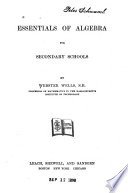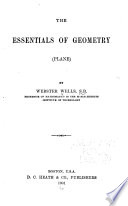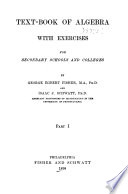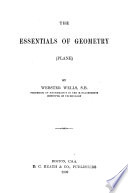 In any proportion the terms are in proportion by Composition ; that is, the sum of the first two terms is to the first term as the sum of the last two terms is to the third term. In any proportion the terms are in proportion by Composition ; that is, the sum of the first two terms is to the first term as the sum of the last two terms is to the third term.  The Elements of Geometry - Page 122by Webster Wells - 1894 - 378 pagesFull view The Elements of Geometry - Page 122by Webster Wells - 1894 - 378 pagesFull view - About this book
 | George Albert Wentworth - Mathematics - 1896 - 68 pages
...be to the first as the fourth to the third. 300. If four quantities are in proportion, they will be in proportion by composition ; that is, the sum of the first two terms will be to the second term as the sum of the last two terms to the fourth term. 301. If four quantities... | |
 | Webster Wells - Algebra - 1897 - 422 pages
...Let the proportion be а : b = с : d. Then, ad = bс. (§ 306) Whence, b : a = d : c. (§ 309) 312. In any proportion, the terms are in proportion by...two terms is to the third term. Let the proportion be a : b = с : d. Then, ad = bс. Adding each member of the equation to ac, ac + ad = ac + bс. Or,... | |
 | Webster Wells - Algebra - 1897 - 386 pages
...third. Let the proportion be a : b = с : d. Then, ad = be. (§ 306) Whence, h:a = d:c. (§309) 312. In any proportion, the terms are in proportion by...two terms is to the third term. Let the proportion be a : b = с : d. Then, ad = be. Adding each member of the equation to ac, ac + ad = ac + be. Or,... | |
 | Webster Wells - Algebra - 1897 - 426 pages
...by Division ; that is, the difference of the first two terms is to the first term as the difference of the last two terms is to the third term. Let .the proportion be a : b = с : d. Then, ad = bc. Subtracting each member of the equation from ac, ac — ad = ac —... | |
 | Webster Wells - Algebra - 1897 - 434 pages
...prove that 313. In any proportion, the terms are in proportion by Division; that is, the difference of the first two terms is to the first term as the difference of the last two terms is to the third term. Let the proportion be a : b = с : d. Then,... | |
 | Webster Wells - Algebra - 1897 - 522 pages
...prove that 313. In any proportion, the terms are in proportion by Division; that is, the difference of the first two terms is to the first term as the difference of the last two terms is to the third term. Let the proportion be a : b = с : d. Then,... | |
 | James Howard Gore - Geometry - 1898 - 232 pages
...„. ., , be ad ac ac that is. - = -» ... . bd ac or b : a = d: c. QED PROPOSITION V. THEOREM. 204. In any proportion the terms are in proportion by Composition...sum of the last two terms is to the third term. Let a:b = c:d. To prove a + &:a::c + d:c. If a:b = c:d, then (by 199) ad = be. Adding both members of the... | |
 | Webster Wells - Geometry - 1898 - 284 pages
...(1) To Prove b : a = d : c. Proof. From (1), ad = be. (?) .-. b:a = d:c. (?) PROP. V. THEOREM. 237. In any proportion, the terms are in proportion by...first term as the sum of the last two terms is to tiie third term. Given the proportion a : b = c : d. (1) To Prove a + b:a = c + d:c. Proof. From (1),... | |
 | George Egbert Fisher, Isaac Joachim Schwatt - Algebra - 1898 - 714 pages
...у г и У и 8. In any proportion, the sum of the first two terms is to the first (or the second) term as the sum of the last two terms is to the third (or the fourth) term. Let a : b = с : d. Then 2 = £. bd Adding 1 to both members, f + 1 = £ + 1,... | |
 | Webster Wells - Geometry - 1898 - 264 pages
...THEOREM. 238. In any proportion, the terms are in proportion by DIVISION ; that is, the difference of the first two terms is to the first term as the difference of the last two terms is to the third term. Given the proportion a:b = c:d, (1) in which... | |
| |